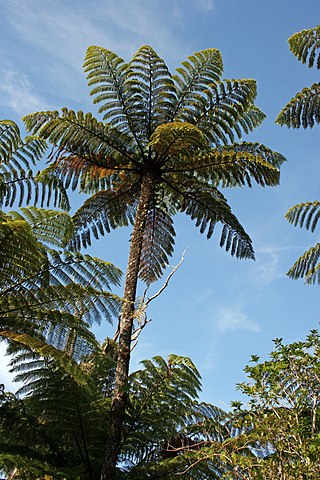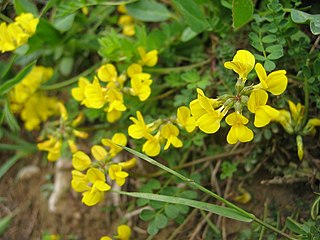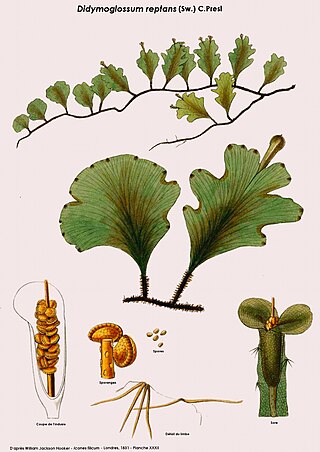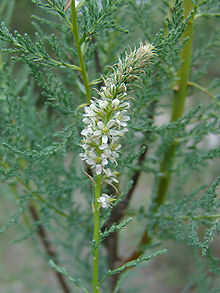
Bauhinia is a large genus of flowering plants in the subfamily Cercidoideae and tribe Bauhinieae, in the large flowering plant family Fabaceae, with a pantropical distribution. The genus was named after the Bauhin brothers Gaspard and Johann, Swiss-French botanists.

Lygodium is a genus of about 40 species of ferns, native to tropical regions across the world, with a few temperate species in eastern Asia and eastern North America. It is the sole genus in the family Lygodiaceae in the Pteridophyte Phylogeny Group classification of 2016. Alternatively, the genus may be placed as the only genus in the subfamily Lygodioideae of a more broadly defined family Schizaeaceae, the family placement used in Plants of the World Online as of November 2019. Per recent molecular evidence, Lygodiaceae is thought to have diverged relatively early from the other members of the Schizaeales due to the relatively high level of synonymous sequence divergence between the families within the Schizaeales.

Pteris (brake) is a genus of about 300 species of ferns in the subfamily Pteridoideae of the family Pteridaceae. They are native to tropical and subtropical regions, southward to New Zealand, Australia, and South Africa, north to Japan and North America. 78 species are found in China. Some species of Pteris have considerable economic and ecological value, such as Pteris multifida, Pteris ensiformis, Pteris vittata can be used for ornamental purposes; as a hyperaccumulator, Pteris multifida and Pteris vittata can be used to control soil pollution.

The genus Tamarix is composed of about 50–60 species of flowering plants in the family Tamaricaceae, native to drier areas of Eurasia and Africa. The generic name originated in Latin and may refer to the Tamaris River in Hispania Tarraconensis (Spain).

Luzula is a genus of flowering plants in the rush family Juncaceae. The genus has a cosmopolitan distribution, with species occurring throughout the world, especially in temperate regions, the Arctic, and higher elevation areas in the tropics. Plants of the genus are known commonly as wood-rush, wood rush, or woodrush. Possible origins of the genus name include the Italian lucciola or the Latin luzulae or luxulae, from lux ("light"), inspired by the way the plants sparkle when wet with dew. Another etymology sometimes given is that it does derive from lucciola but that this meant a mid-summer field, or from the Latin luculus, meaning a small place; the same source also states that this name was applied by Luigi Anguillara in 1561.

Zoysia is a genus of creeping grasses widespread across much of Asia and Australia, as well as various islands in the Pacific. These species, commonly called zoysia or zoysiagrass, are found in coastal areas or grasslands. It is a popular choice for fairways and teeing areas at golf courses. The genus is named after the Slovenian botanist Karl von Zois (1756–1799).

Cyathea is a genus of tree ferns, the type genus of the fern order Cyatheales.

Polypodiaceae is a family of ferns. In the Pteridophyte Phylogeny Group classification of 2016, the family includes around 65 genera and an estimated 1,650 species and is placed in the order Polypodiales, suborder Polypodiineae. A broader circumscription has also been used, in which the family includes other families kept separate in PPG I. Nearly all species are epiphytes, but some are terrestrial.

The Tamaricaceae, the tamarisk family, are a family of plants native to drier areas of Europe, Asia, and Africa. It contains four genera: Tamarix, Reaumuria, Myricaria, and Myrtama.

Pellaea is a genus of ferns in the Cheilanthoideae subfamily of the Pteridaceae. The genus name is derived from the Greek word πελλος (pellos), meaning "dark," and refers to the brown stems. Many members of the genus are commonly known as cliffbrakes. They primarily grow in rocky habitats, including moist rocky canyons, slopes, and bluffs.

Notholaena, cloak fern, is a genus of ferns in the Cheilanthoideae subfamily of the Pteridaceae. Ferns of this genus are mostly epipetric or occurring in coarse, gravelly soils, and are most abundant and diverse in the mountain ranges of warm arid or semiarid regions. They typically have a creeping or erect rhizome and leaves that are pinnatifid to pinnate-pinnatifid with marginal sori protected by a false indusium formed from the reflexed margin of the leaf. Members of Notholaena also have a coating of whitish or yellowish farina on the surfaces of the leaves. The farina is often limited to the abaxial (lower) leaf surface, but may occur on the adaxial (upper) leaf surface as well. Members of the related Pentagramma genus have a similar lower leaf-surface farina.

The genus Securigera contains a number of plant species commonly referred to as crownvetch. It is a segregate of the genus Coronilla. The name Securigera was first published by A. P. de Candolle in 1805 with the single species Securigera coronilla, which is now considered to be a synonym of Securigera securidaca(L.) Degen & Dörfl. (1897), based on the earlier publication of the same taxon as Coronilla securidacaL. in 1753.

Hippocrepis is a genus of flowering plants in the legume family, Fabaceae. It includes 34 species native to Europe, northern Africa, and western Asia.

Tectaria is a genus of fern in the family Tectariaceae, according to the Pteridophyte Phylogeny Group classification of 2016. Halberd fern is a common name for species in this genus.

Didymoglossum is a tropical genus of ferns in the family Hymenophyllaceae. It comprises more than 30 epilithic or low-epiphytic species under two subgenera. The genus is accepted in the Pteridophyte Phylogeny Group classification of 2016, but not by some other sources which sink it into a broadly defined Trichomanes.

Thalassia hemprichii, called Pacific turtlegrass, is a widespread species of seagrass in the genus Thalassia, native to the shores of the Indian Ocean, the Red Sea, and the western Pacific Ocean. Its growth rate increases with CO2 enrichment, and it can tolerate lowered light conditions caused by algal blooms, allowing for it to respond positively to ocean acidification and other disturbances.
Meniocus is a genus of flowering plants belonging to the family Brassicaceae.
















